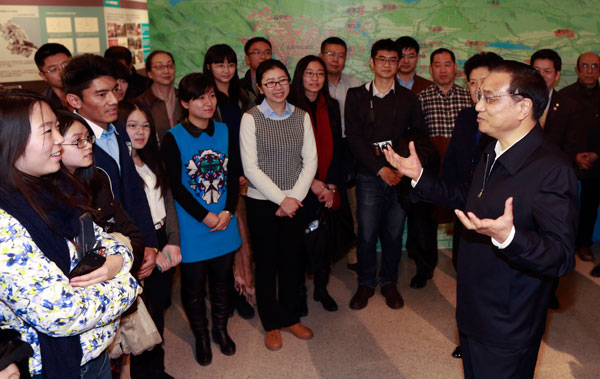 |
|
Premier Li Keqiang talks to students and teachers from Tsinghua University during a visit to a human settlement science exhibition at the National Museum of China on Thursday. |
Urbanization should not be limited to prosperous eastern China, according to Premier Li Keqiang.
Underdeveloped central and western areas of the country need similar development, if not more, to ensure residents there can have an equally comfortable and convenient lifestyle, he said.
Li made the remarks during a visit to a human settlement science exhibition in Beijing on Thursday.
He said human settlement science, which involves architecture, urban planning, geography, the environment and cultural studies, fits perfectly with the new urbanization project the government has been pushing for, as both are people-oriented.
"The mission of urbanization is not for the sake of land or buildings, but for the people," Li said.
He said the rebuilding of shantytowns and the urbanization process should be speeded up to meet the urgent needs of residents to improve their living conditions.
As technology develops, China can have a better-balanced distribution of its population in the west and east, and better solve problems surrounding natural resources, water, air pollution and ecological protection, he said.
Li encouraged college students visiting the exhibition to go to western areas after they graduate to help these areas to develop.
The exhibition, at the National Museum of China, showed the evolution of the nation's human settlement science and urban planning. This topic has been studied by Wu Liangyong, the founder of human settlement science in China, and his team over the years.
Wu, 92, and his team have researched a series of projects, including the possibility of coordinated development for the Beijing-Tianjin-Hebei cluster and plans to make Beijing a more livable capital.
The team released the third report on the issue last year, saying that coordinated development of the three areas requires integration in urban planning, transportation, ecological protection and cultural development.
The State Council has unveiled a plan for a new type of urbanization for 2014 to 2020 in an attempt to put China’s urbanization on a human-centered and environmentally friendly path.
Authorities are aiming for an urbanization rate of 60 percent by 2020. The figure stood at 53.7 percent at the end of last year, according to the National Bureau of Statistics.
Xue Lan, dean of the School of Public Policy and Management at Tsinghua University, said human-centered urbanization is not a physical expansion of cities, but involves the urbanization of people, from rural to urban areas.
He suggested that a cost-sharing system be explored in pilot regions to help migrant workers settle in cities and obtain access to social services.
